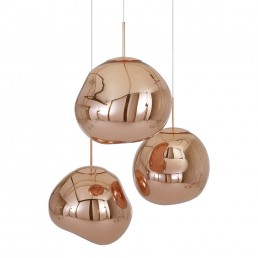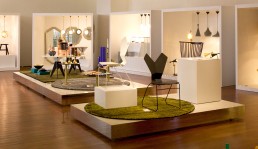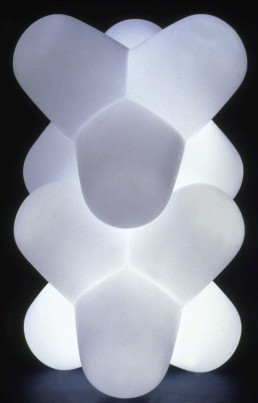Visiting Macau for an exhibition of his most sought-after creations, British design’s favourite maverick Tom Dixon celebrates royalty, sustainability, regionality and not really knowing what he’s doing.
AWARDED AN OBE for services to British design in 2000, and with his creations gracing the permanent collections of London’s Victoria and Albert Museum, New York’s Museum of Modern Art and the Centre Georges Pompidou in Paris, Tom Dixon has earned his seat among the world’s most on-trend designers of homeware.
Since 2002, he has helmed his eponymous company Tom Dixon (the smart money’s go-to for quirky lighting and conversation-starting furniture; for irreverent, zeitgeist-y home accessories) and been embraced by the chattering classes. And yet the labels most often pinned on the softly spoken 55-year-old are “maverick” and “rebel”.
“‘Maverick’ is getting harder and harder to justify,” says Dixon, taking a break from the media pack that has converged on the Louis Vuitton store in Macau’s plush One Central mall for the opening of an exhibition of his most iconic pieces. “At the same time, some people are saying I’m now ‘establishment’.
“The problem with the modern world is that you can’t shake anything off — people just add to it. I’d like be seen as more multi-layered, and maybe have to live with ‘establishment maverick’ or some other kind of hybrid.”
DIXON HAS COME south having just attended an exhibition of British creativity in Shanghai, where he gave visiting Prince William a hurried lesson in welding for media cameras. “Luckily, he did better than expected,” Dixon says of the second in line to the British throne. “It was close to a disaster, that stunt — the machine jammed three minutes before he arrived. He’s a class act, however. I was impressed.”
Being able to weld is important to Dixon. Welding, after all, is the humble skill he exploited to carve out a glamorous career, and which now has him hobnobbing with royalty.
“British history is littered with people who were non-experts … I would never have attempted three-quarters of what I’ve done if I’d been any good at it”
Tom Dixon
Born in Tunisia to a French-Latvian mother and an English father, Dixon was raised in London from the age of four. He dropped out of art school as a young man to play bass guitar with Latin-tinged dance band Funkapolitan, which enjoyed minor chart success in the early 1980s.
A love of motorbikes — and occasional need to repair them — saw him scouring junkyards for scrap parts and learning how to weld. Soon, in tune with the post-punk DIY ethos of the time, Dixon was salvaging iron grates, scaffolding and other metallic detritus to forge one-off pieces that he called “welded salvage furniture”.
“I’ve always found that I’m better off when I don’t know too much about something, so I don’t come loaded with preconceptions,” Dixon says of his lack of formal design training. “I like to come to projects with slightly more child-like eyes.
“British history is littered with people who were non-experts and came at things from a slightly different angle. I would never have attempted three-quarters of what I’ve done if I’d been any good at it.”
WITH TIME, DIXON’S fresh, impudent approach caught the eye of the heavyweights of European design. One of the most successful of his early creations was his distinctive S-Chair, which was snapped up for manufacture by Italian luxury furniture giant Cappellini. The chair was modelled on a doodle of a chicken that Dixon had made on a napkin.
In the early 1990s, his polyethylene “sitting, stacking, lighting thing” — simply called Jack — made his design aesthetic recognisable the world over. Dixon’s Mirror Ball lights, encased in highly reflective glass spheres, have since become part of the contemporary design landscape from Beijing to Buenos Aires.
Dixon, however, who described his 2013 book Dixonary — which explores the highlights of his career so far — as “illuminations, revelations and post-rationalisations from a chaotic mind”, is surprisingly dismissive of his triumphs.
“It’s very satisfying to know that some of my work has gone into museums and appears in design books, but I can’t ultimately say that I’m really very satisfied with anything,” he says. “I’m quite self-critical, and that’s what makes you do the next piece.”
“You do get a certain guilty feeling producing more stuff in a world that doesn’t necessarily needs loads more stuff”
Tom Dixon
While he argues that London — home to Tom Dixon the brand — and that city’s “openness to the world” offers advantages for a designer working on the international stage, he wonders if the concept of design as a universal language transcending national borders is flawed.
“The iPhone has managed to do that quite well, but I think people retain a sense of place,” he argues. “An analogy that works, I think, is food. For a long time everybody was into ‘fusion’. What people want now is ‘authentic’, ‘real’ and ‘original’ food.
“New Scandinavian design — this quite sensible, pastel-y approach — is very successful right now, so I think national identities are being maintained. You can tell Japanese design, for instance, a long way off.”
And while Dixon recognises that consumerism and the constant reinvention of products lie at the heart of the design industry (for 10 years, kicking off in 1998, he was head of design and then creative director at £500-million-turnover British retail legend Habitat), he says he increasingly aims for longevity in his work by avoiding trends and insisting on high craftsmanship.
“You do get a certain guilty feeling producing more stuff in a world that doesn’t necessarily needs loads more stuff,” he says. “I have an interest in sustainability. I think every designer should. I’m old enough now to have quite a lot of stuff that has gone into the secondary market, and the things that survive are those that look better with age, and that’s a quality I strive for.”
ULTIMATELY, DESPITE HIS many successes, Dixon’s autodidactic beginnings still appear to inform his aesthetic and sensibilities. When the subject of exclusivity is broached, the maverick and rebel — if only momentarily — appears to break through the media-savvy gloss.
“I have some trouble with that word,” he says when asked if Tom Dixon products are “luxury” goods, “but I can’t deny that they are expensive. I’m atypical of most designers, having worked at all kinds of levels.
“I worked for Habitat when it was part of Ikea. When I first started, I was selling things for 15 quid just to get rid of them and start the next one. I’ve worked in proper luxury — with the Italians — as well, so I’m going to go for ‘reassuringly expensive’.
“The context here, of course, in the LV Gallery, is a super, hyper-luxury context, but I see my stuff in rough bars, and I’ve seen very cheap copies of my lamps in Starbucks in Shanghai. So, in a way, I’ve achieved affordability through being copied.” ◉
This story was commissioned by Hong Kong Tatler magazine in 2015. Download PDF.
SHARE







